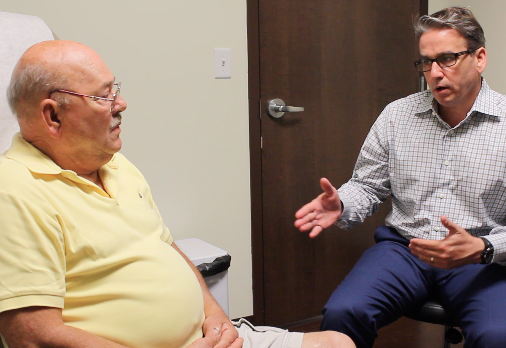Aortic Dissection
 The aorta is the largest and most important blood vessel in the body. Originating from the heart, this aorta transports much-needed nutrients to the chest, abdomen, and legs. An aortic dissection occurs when the inner lining of the artery ruptures. Blood then floods the tear resulting in the separation (dissection) of its inner and central layers. If blood overflows beyond the outer wall of the aorta, aortic dissection can often result in death.
The aorta is the largest and most important blood vessel in the body. Originating from the heart, this aorta transports much-needed nutrients to the chest, abdomen, and legs. An aortic dissection occurs when the inner lining of the artery ruptures. Blood then floods the tear resulting in the separation (dissection) of its inner and central layers. If blood overflows beyond the outer wall of the aorta, aortic dissection can often result in death.
Aortic dissection represents the most frequent trauma of the aorta and is 2-3 times more prevalent than abdominal aortic tearing. If left untreated, more than one-third of patients will die within the first 24 hours, and half will die within 48 hours.
There are two main classifications of aortic dissection, type A and type B, depending on which part of the aorta has been affected. When it leaves the heart, the aorta moves and arches upward toward the head; this is called the ascending aorta. It then curves downward, moving into the chest and abdomen – this is known as the descending aorta. Both type A and type B aortic dissections are managed and treated by board-certified vascular surgeons in particular ways:
- Type A — The rupture originates in the ascending aorta and extends throughout the body, reaching as far as the arteries in the leg. Immediate surgery is urgently needed to prevent a heart attack, stroke, congestive heart failure and hemorrhaging.
- Type B — The tear originates in the descending aorta only, but can spread as far as the abdomen. Type B dissections are generally less life-threatening than type A, and may not require urgent surgical treatment. Aggressive blood pressure controls are usually the first line of defense.
Causes and Risk Factors Leading to an Aortic Dissection
Aortic dissection remains a relatively infrequent phenomenon. It occurs most often in older men between the ages of 50-70 and risk tends to increase with age.
Other factors that can increase the likelihood of an aortic dissection include:
- Chronic high blood pressure can create undue stress on the aortic walls, increasing the likelihood of a tear
- Atherosclerosis (buildup of plaque in the arteries)
- Any inherited or other condition that can impair the functioning of the aorta or weaken the blood vessels’ tissues, such as congenital heart disease or Marfan syndrome
- Surgery performed close to the heart
- Trauma to the chest (from a car accident)
- Smoking
- Cocaine use can impair connective tissue and cause sudden and extreme circulation irregularities
- The third trimester of pregnancy
About 30% of patients with PAD die within 5 years, usually due to an ischemic coronary event.
Symptoms and Treatment Resulting in an Aortic Dissection
Symptoms resulting in an aortic dissection occur suddenly and can be similar to other heart conditions such as a heart attack or stroke. Abrupt and intense “tearing” pain in between the shoulder blades or behind the breastbone is often experienced.
Other common symptoms may include:
- Loss of consciousness
- Shortness of breath and extreme anxiety
- Weakness, loss of vision, fainting, or dizziness
- Rapid, weak pulse in one arm
- Pain spreading to the arms, legs, or abdomen
- Intense sweating
- Nausea, vomiting, or difficulty swallowing
Aortic dissection is a serious, critical condition that needs treatment right away. Depending on which type of dissection is involved, the treatment protocol will differ.
Type A aortic dissections require swift diagnosis and surgical intervention. Standard, open surgery through an incision in the chest or abdomen is typically employed. During the procedure, the surgeon will clear out the damaged artery and repair the tear in the aortic wall by use of a graft (tiny tube).
Blood pressure medication may be given prior to surgery to stabilize the patient’s blood pressure and heart rate.
There is no clear-cut treatment for type B aortic dissection. If the condition is not deemed to be complicated or life threatening, immediate surgical intervention may not be required, and the patient will be prescribed blood pressure medication. If however, a distal dissection has ruptured, affecting blood circulation to vital organs, surgery may indeed be recommended.
Recovery and Prevention from an Aortic Dissection
 When an aortic dissection is detected early on before the aorta ruptures and is treated promptly, the chance of survival greatly improves. However, less than 50% of patients with a torn aorta survive and roughly 20% of patients die before arriving at the hospital.
When an aortic dissection is detected early on before the aorta ruptures and is treated promptly, the chance of survival greatly improves. However, less than 50% of patients with a torn aorta survive and roughly 20% of patients die before arriving at the hospital.
For those patients who survive the dissection, the five-year survival rate is roughly 60%, and the ten-year survival rate at 40%. Many patients who survive the initial episode are often prescribed beta-blockers for the rest of their lives, as well as undergo regular CAT scans or MRIs to track their condition.
Certain cases of aortic dissection cannot be prevented. However, there are things one can do to reduce one’s chances of developing it:
- Treating atherosclerosis
- Controlling hypertension and frequent monitoring of one’s blood pressure
- Quitting smoking
- Maintaining an optimal body weight, exercise regularly, and follow a healthy diet with sufficient fruits and vegetables
- Working closely with one’s physician, especially when a genetic history of heart condition, aortic dissection or connective tissue disease is involved

